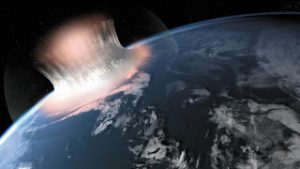
A 100 kilometre-wide crater has been found in Greenland, the result of a massive asteroid or comet impact a billion years before any other known collision on Earth.
The spectacular craters on the Moon formed from impacts with asteroids and comets between 3 and 4 billion years ago. The early Earth, with its far greater gravitational mass, must have experienced even more collisions at this time — but the evidence has been eroded away or covered by younger rocks. The previously oldest known crater on Earth formed 2 billion years ago and the chances of finding an even older impact were thought to be, literally, astronomically low.
Now, a team of scientists from Cardiff, the Geological Survey of Denmark and Greenland (GEUS) in Copenhagen, Lund University in Sweden and the Institute of Planetary Science in Moscow has upset these odds. Following a detailed programme of fieldwork, funded by GEUS and the Danish ‘Carlsbergfondet’ (Carlsberg Foundation), the team have discovered the remains of a giant 3 billion year old impact near the Maniitsoq region of West Greenland.
“This single discovery means that we can study the effects of cratering on the Earth nearly a billion years further back in time than was possible before,” according to Dr Iain McDonald of the School of Earth and Ocean Sciences, who was part of the team.
Finding the evidence was made all the harder because there is no obvious bowl-shaped crater left to find. Over the 3 billion years since the impact, the land has been eroded down to expose deeper crust 25 km below the original surface. All external parts of the impact structure have been removed, but the effects of the intense impact shock wave penetrated deep into the crust — far deeper than at any other known crater — and these remain visible.
However, because the effects of impact at these depths have never been observed before it has taken nearly three years of painstaking work to assemble all the key evidence. “The process was rather like a Sherlock Holmes story,” said Dr McDonald. “We eliminated the impossible in terms of any conventional terrestrial processes, and were left with a giant impact as the only explanation for all of the facts.”
Only around 180 impact craters have ever been discovered on Earth and around 30% of them contain important natural resources of minerals or oil and gas. The largest and oldest known crater prior to this study, the 300 kilometre wide Vredefort crater in South Africa, is 2 billion years in age and heavily eroded.
Dr McDonald added that “It has taken us nearly three years to convince our peers in the scientific community of this but the mining industry was far more receptive. A Canadian exploration company has been using the impact model to explore for deposits of nickel and platinum metals at Maniitsoq since the autumn of 2011.”
Note : The above story is reprinted from materials provided by Cardiff University.










